History and exam
Key diagnostic factors
common
presence of risk factors
Occupational, recreational, and geographical exposure to insects can increase the risk of being bitten or stung. History of anaphylactic or anaphylactoid responses increases the risk of severe allergic reactions.
witnessed bite/sting
Only when encounters are witnessed can diagnosis of bite or sting be made with certainty. For winged Hymenoptera, however, identification of the culprit insect may not always be reliable from patients.[Figure caption and citation for the preceding image starts]: Honeybee stinging fleshCourtesy of Rick Vetter [Citation ends].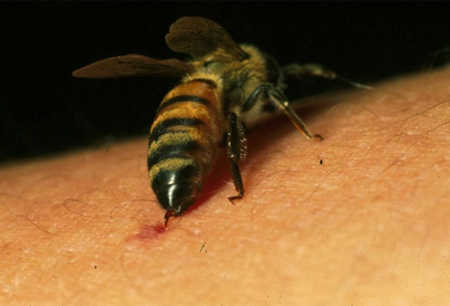 It is likely that the majority of patients attributing their reaction to spider bites are in fact suffering from local skin infections or other reactions not due to spider bites.[11][12]
It is likely that the majority of patients attributing their reaction to spider bites are in fact suffering from local skin infections or other reactions not due to spider bites.[11][12]
local oedema
Swelling at the bite/sting site is usually present and develops acutely.[24][Figure caption and citation for the preceding image starts]: Periorbital swelling 24 hours after yellow jacket sting above right eyeCourtesy of Tom Morrissey [Citation ends].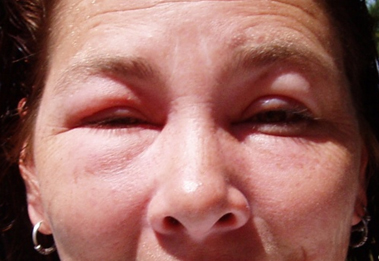 May also be a sign of cellulitis if it develops a few days after the sting, although secondary infection is rare.
May also be a sign of cellulitis if it develops a few days after the sting, although secondary infection is rare.
local pain
May or may not be present or may be a late sign.
local warmth
May or may not be present.
local markings
Acutely, spider bites may show one or two small fang marks. Stinging ants may leave circle of stings because they bite with their mouth and rotate while stinging with abdominal organs. [Figure caption and citation for the preceding image starts]: Pseudopustule formation following fire ant stingCourtesy of Theodore Freeman [Citation ends].
pruritus
When at the sting site, characteristic of local or large local reactions. When occurring on large areas of the body not directly adjacent to the site of the sting, characteristic of systemic allergic reactions, including anaphylaxis.
wheal and flare
Such formation is characteristic of local or large local reactions. [Figure caption and citation for the preceding image starts]: Wheal formation following wasp stingCourtesy of Theodore Freeman [Citation ends].
skin pallor
May indicate vasoconstriction in cases of severe allergic response.
clamminess
May indicate vasoconstriction in cases of severe allergic response.
uncommon
signs of airway compromise
Sign of life-threatening anaphylactic response. May occur due to oropharyngeal oedema. Stridor is usually inspiratory and may be heard over the neck or throat. In some cases, stridor may be due to vocal cord dysfunction which can mimic anaphylaxis but does not usually cause difficulty with expiration. Drooling may occur when patients are unable to swallow their own secretions. Air hunger may also be present.
oropharyngeal oedema
There may be swelling of the mouth, tongue, or pharynx, which may be a sign of life-threatening anaphylaxis. This may lead to airway obstruction.
dyspnoea
Patients may be working hard to breathe or breathing fast in life-threatening anaphylactic responses (although this is not specific for anaphylaxis).
rales/crackles/wheeze
May be a sign of cardiovascular failure in life-threatening anaphylactic responses. Wheeze is usually expiratory and heard over the lungs.
tachycardia
irregular pulse
May be a sign of life-threatening anaphylactic response.
skin flushing
May indicate vasodilation in cases of severe allergic response.
altered alertness
May indicate severe allergic response. May be due to the neurological effects of black widow spider bites. [Figure caption and citation for the preceding image starts]: Black widow (Latrodectusspecies); the red hourglass marking is not always this shape and may not be presentCourtesy of Rick Vetter [Citation ends]. [Figure caption and citation for the preceding image starts]: Black widow (Latrodectus species)Courtesy of Bill Banner [Citation ends].
[Figure caption and citation for the preceding image starts]: Black widow (Latrodectus species)Courtesy of Bill Banner [Citation ends].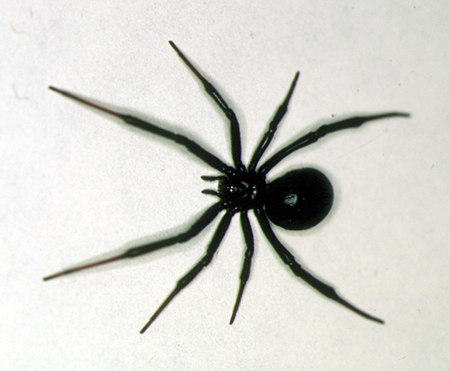
Other diagnostic factors
common
pustules
May be present in relation to specific insects. A ring of small pustules is indicative of fire ant stings. [Figure caption and citation for the preceding image starts]: Pseudopustule formation following fire ant stingCourtesy of Theodore Freeman [Citation ends].
bullseye-shaped rash
Following tick bites, this is indicative of Lyme disease. [Figure caption and citation for the preceding image starts]: Erythema migrans of Lyme diseaseCourtesy of Janak Koirala, MD, MPH; Tin Han Htwe, MD; and Christian Speil, MD [Citation ends].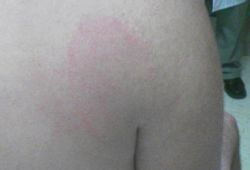
rash on palms and soles
Following tick bites, this is indicative of Rocky Mountain spotted fever.
linear raised rash
May represent urticating caterpillars or a contact dermatitis (like poison ivy) rather than an insect sting.
hypertension
fever
Fever may be present due to local infection, cellulitis, or serum sickness (uncommon delayed reaction usually occurring about a week after envenomation).
muscle cramp
diaphoresis
tremor
May be due to the neurological effects of black widow spider bites.[37]
paraesthesia and/or fasciculations
May be due to the neurological effects of black widow spider bites.[37]
generalised pain
May be due to the neurological effects of black widow spider bites.[37]
nausea/vomiting
May indicate severe allergic response.
headache
It may indicate the presence of serum sickness (uncommon delayed reaction usually occurring about 1 week after envenomation).
abdominal pain
history of immunocompromised state
Places patients at higher risk of secondary infection following bites or stings.
history of cardiovascular disease
Cardiovascular disease can be aggravated by both the insult and the treatment. Beta-blockers and other medications can interfere with medications used to treat the insult.
uncommon
abscess
May be present several days after a bite or sting, and usually has palpable fluctuance.
necrosis
Rarely, recluse spider bites can develop slow, but relentlessly progressive, local tissue necrosis. [Figure caption and citation for the preceding image starts]: Brown recluse spider (Loxosceles species)Courtesy of Rick Vetter [Citation ends].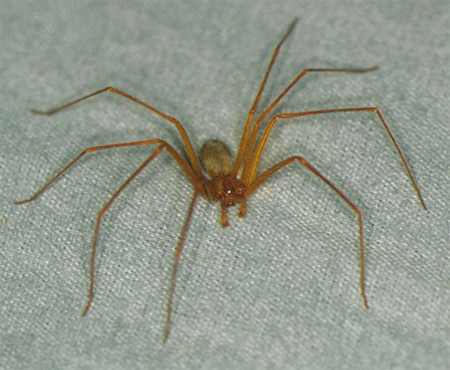 [Figure caption and citation for the preceding image starts]: Lesions from reported brown recluse (Loxoscelesspecies) envenomationCourtesy of Theodore Freeman [Citation ends].
[Figure caption and citation for the preceding image starts]: Lesions from reported brown recluse (Loxoscelesspecies) envenomationCourtesy of Theodore Freeman [Citation ends]. [Figure caption and citation for the preceding image starts]: Lesions from reported brown recluse (Loxosceles species) envenomationCourtesy of Theodore Freeman [Citation ends].
[Figure caption and citation for the preceding image starts]: Lesions from reported brown recluse (Loxosceles species) envenomationCourtesy of Theodore Freeman [Citation ends]. Fire ant stings cause localised tissue necrosis and the formation of a characteristic sterile pustule about 24 hours after the sting.[22][23][Figure caption and citation for the preceding image starts]: Pseudopustule formation following fire ant stingCourtesy of Theodore Freeman [Citation ends].
Fire ant stings cause localised tissue necrosis and the formation of a characteristic sterile pustule about 24 hours after the sting.[22][23][Figure caption and citation for the preceding image starts]: Pseudopustule formation following fire ant stingCourtesy of Theodore Freeman [Citation ends].
cough
Allergic reactions may manifest as cough.
hypotension
Immunoglobulin E-mediated histamine release in severe reactions can result in hypotension. May be due to the neurological effects of black widow spider bites.
arthralgia
May occur due to serum sickness (uncommon delayed reaction usually occurring about a week after envenomation).
adenopathy
May occur due to serum sickness (uncommon delayed reaction usually occurring about a week after envenomation).
Risk factors
strong
occupational or recreational exposure to insects
People are more likely to get bitten or stung if they engage in behaviours that place them in close contact with culprit bugs. Camping, gardening, landscaping, and spring-cleaning are high-risk activities.
Bites and stings occur more often in the spring and summer months for some insects, and early autumn for others, when the bugs are more prevalent and people are outside more.
geographical exposure to insects
Many spiders and some insects are found in distinct geographical locales, although the ease and frequency of travel in recent decades makes it impossible to rule out exposure based on geography alone.
Spider bites usually result from reaching blindly into the environment of a spider or accidentally pressing the skin against the spider (e.g., putting on clothing containing a spider or cleaning the garage).
previous history of anaphylactic response
Patients who have experienced severe reactions to bites or stings in the past have a high likelihood of experiencing similar reactions to future exposures. Although it has been widely held that the chance of another severe reaction declines with time (i.e., outgrowing the allergy), this is generally not the case in adults in whom the risk remains 30% or more over 2 decades or more.[29]
Use of this content is subject to our disclaimer